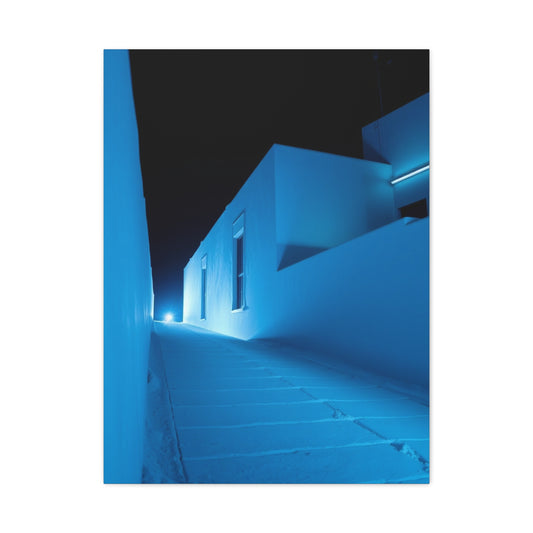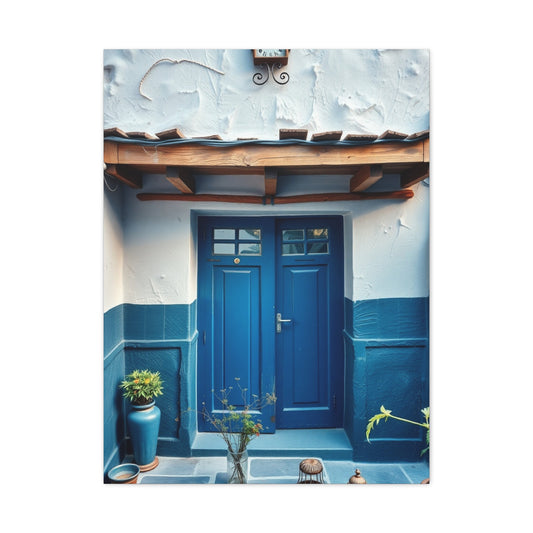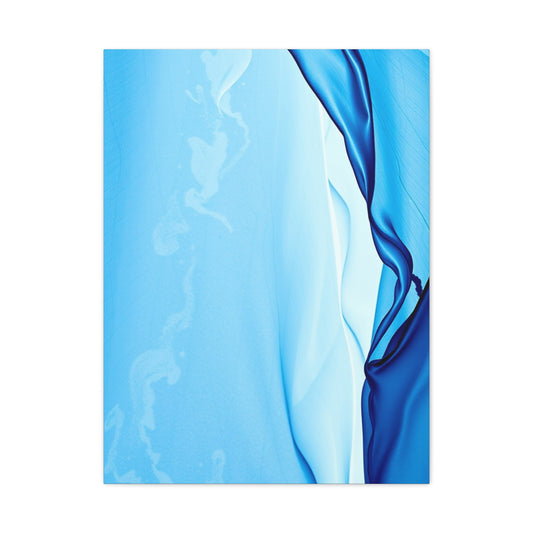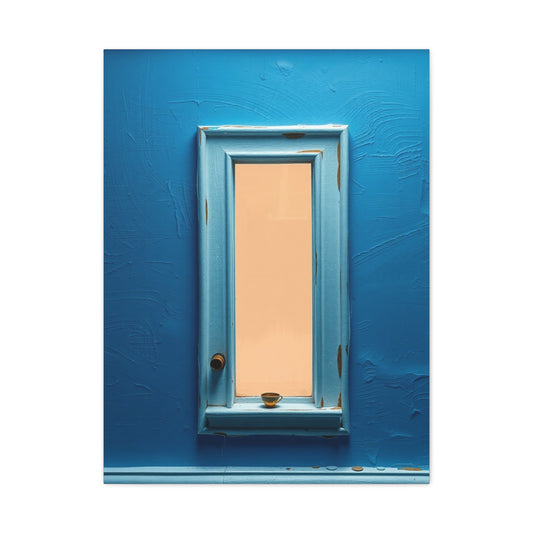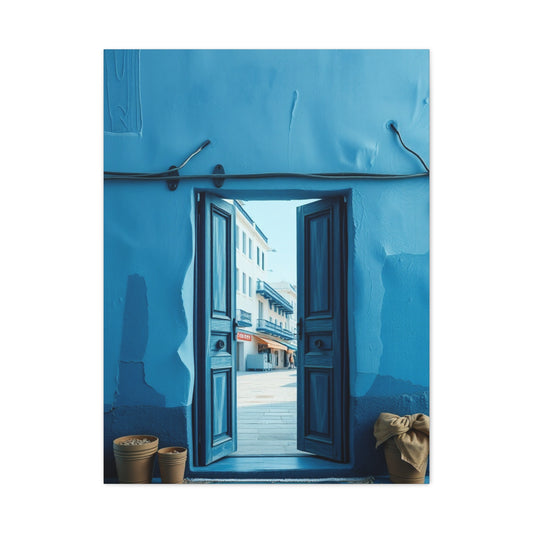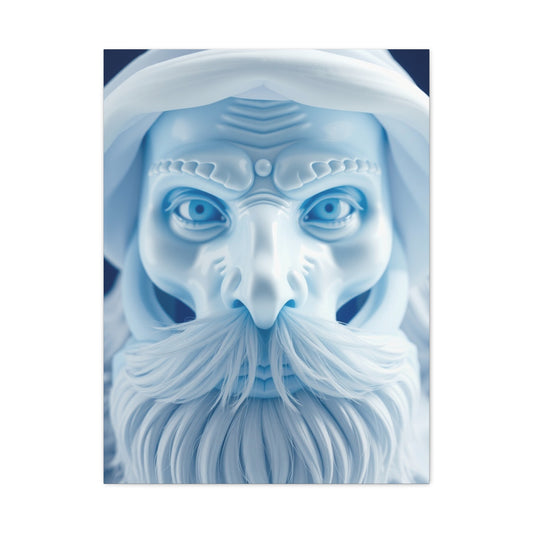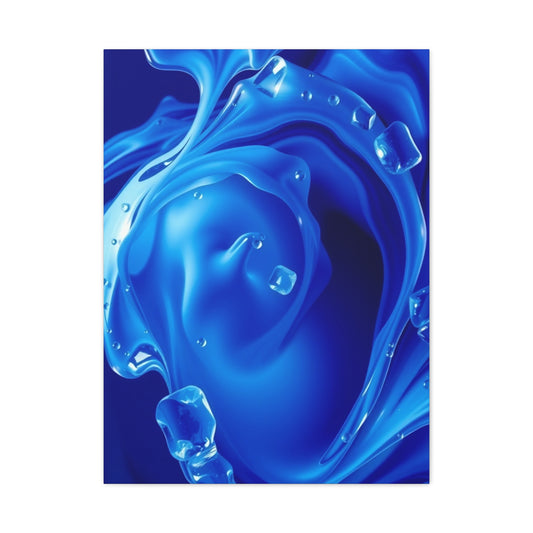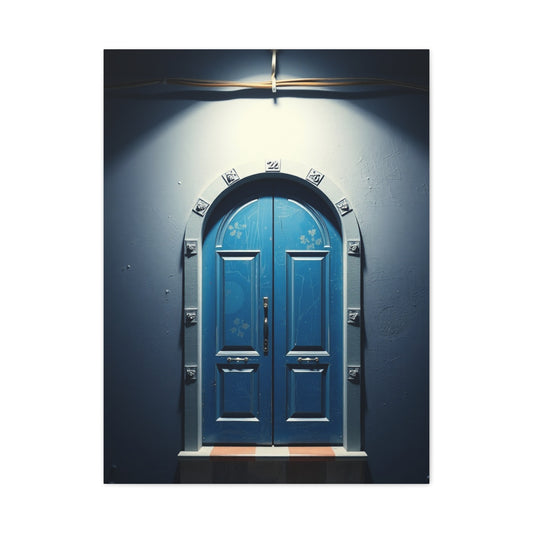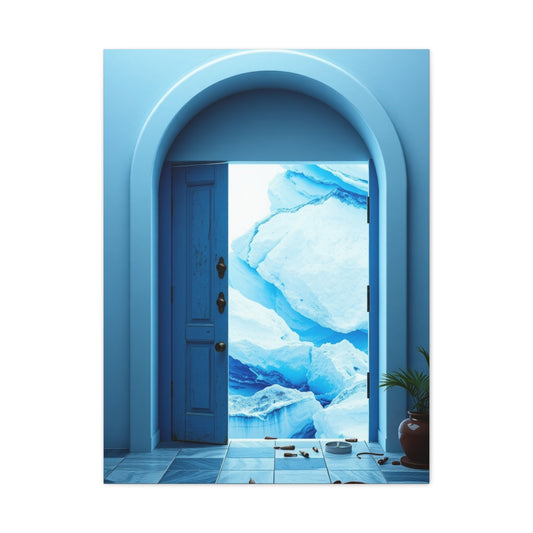Blue-and-White Floral Wall Art Prints: Timeless Elegance for Contemporary Interiors
The captivating allure of blue-and-white floral wall art lies in its ability to seamlessly merge visual sophistication with emotional tranquility. Cerulean and ivory hues, delicately intertwined in botanical motifs, create a design language that is at once timeless and versatile. Unlike fleeting trends that dominate the interior design landscape for a season or two, these color combinations have endured across centuries, demonstrating an unmatched capacity to elevate living spaces with understated refinement. The crisp purity of ivory paired with the calming depth of oceanic blues establishes an atmosphere of serenity that resonates throughout a room, encouraging relaxation, reflection, and aesthetic appreciation simultaneously.
Historically, sapphire-and-alabaster floral patterns have been celebrated for their adaptability. In European manor houses of the 17th and 18th centuries, these prints adorned walls, textiles, and decorative ceramics, symbolizing elegance, cultural sophistication, and a refined attention to detail. Over time, the motifs have transcended their traditional roots, seamlessly integrating into contemporary interiors characterized by minimalist principles, clean lines, and open-plan spatial layouts. This enduring versatility ensures that blue-and-white botanical designs remain relevant across a multitude of architectural styles, from classical to modernist, offering homeowners a design element that can complement both heritage spaces and cutting-edge contemporary interiors.
The psychological dimension of these color combinations further amplifies their appeal. Blue is universally recognized for its calming and stabilizing qualities, evoking feelings of trust, peace, and mental clarity. When balanced with pristine white, the visual effect is heightened, creating spaces that feel open, airy, and rejuvenating. Botanical motifs reinforce these benefits, leveraging the innate human affinity for natural forms—a concept widely embraced in biophilic design principles. This connection to nature can promote emotional well-being, reduce stress, and enhance cognitive focus, making these prints not only visually captivating but also psychologically enriching.
From an aesthetic standpoint, the versatility of blue-and-white floral artwork allows it to serve multiple roles within interior spaces. It can act as a striking focal point above a sofa or headboard, provide subtle cohesion in gallery wall arrangements, or offer seasonal adaptability when paired with textiles, cushions, and decorative accessories. Its timeless charm ensures that rooms remain visually compelling while maintaining a sense of harmony and composure. By marrying historical elegance with contemporary design sensibilities, blue-and-white botanical prints continue to captivate designers and homeowners alike, reaffirming their status as an essential element for interiors that aspire to sophistication, balance, and enduring beauty.
Historical Roots of Cobalt and Ivory Botanical Prints
The timeless appeal of blue and white botanical prints has a rich and multifaceted history that spans continents and centuries. The tradition of combining deep cobalt hues with soft ivory backgrounds first emerged prominently in ancient China, where porcelain artisans mastered the delicate balance of color and form. Chinese craftsmen meticulously painted intricate floral patterns on porcelain vessels, often using cobalt oxide, which produced a strikingly vivid blue after firing. These creations were not merely decorative; they symbolized elegance, refinement, and a deep appreciation for nature’s subtleties. Over time, these porcelain pieces became highly coveted trade items, influencing artistic sensibilities far beyond East Asia.
By the late Middle Ages and into the European Renaissance, Western artisans began to draw inspiration from these imported Chinese porcelain works. European craftsmen, particularly in the Netherlands, embraced these exotic aesthetics, adapting them to local tastes. The Dutch developed what became known as Delftware, renowned for its brilliant cobalt-blue patterns on smooth white ceramics. These designs often incorporated stylized botanical motifs—tulips, roses, and intricate vines—intertwining Eastern influences with European artistic sensibilities. The diffusion of such motifs extended beyond pottery, finding expression in textiles, tapestries, wallpapers, and even architectural ornamentation. This cross-cultural synthesis marked a pivotal moment in the global appreciation of blue-and-white floral aesthetics, embedding these designs into the visual lexicon of European decorative arts.
The 19th century, particularly the Victorian era, witnessed a peak in the domestic popularity of cobalt-and-ivory botanical prints. In affluent households, these motifs were emblematic of cultural sophistication and social refinement. Wallpapered drawing rooms, embroidered curtains, and luxurious bed linens often featured these intricate floral designs, creating interiors that conveyed both taste and status. The appeal lay not only in their beauty but also in their symbolic resonance; the blue-and-white color palette evoked serenity, purity, and timeless elegance. This enduring fascination ensured that such botanical prints became a staple of interior design, transcending trends and continuing to inspire contemporary decor.
Even today, the aesthetic principles established by these historical prints influence modern interior design. From minimalist Scandinavian interiors to opulent classical settings, cobalt and ivory floral motifs lend a sense of balance, sophistication, and enduring charm. They remain a testament to the intersection of artistry, cultural exchange, and the timeless human desire to bring nature’s beauty into the domestic sphere.
Psychological Impact of Indigo and Ivory Floral Art
The use of indigo and ivory floral art in interior design extends far beyond mere decoration; it holds substantial psychological benefits that influence mood, cognition, and overall well-being. Color psychology consistently demonstrates that shades of blue, particularly deep indigo, evoke feelings of calmness, serenity, and emotional stability. Blue’s naturally cooling and soothing qualities help reduce anxiety and mental fatigue, creating spaces where occupants feel balanced and composed. When paired with ivory or soft white tones, these calming effects are intensified. The juxtaposition of deep indigo with pale, neutral hues encourages visual clarity and mental focus, supporting environments conducive to contemplation, productivity, or relaxation.
Floral motifs further enhance the psychological benefits of indigo and ivory art. The incorporation of natural forms in visual design aligns with biophilic principles, which suggest that humans possess an innate affinity for nature and natural patterns. Even in highly urbanized or modern interiors, floral imagery can create a sense of connection to the natural world, alleviating the stress associated with enclosed or artificial environments. Research indicates that viewing floral patterns or botanical designs can reduce cortisol levels, lower blood pressure, and improve overall emotional well-being. This effect is particularly potent when the patterns are rendered in harmonious color combinations, such as the elegant interplay of indigo and ivory.
Moreover, indigo and ivory floral art can subtly influence perception and emotional states. The depth of indigo encourages introspection and serenity, while the lightness of ivory introduces a sense of openness and purity. Together, these colors create a balanced environment that simultaneously stimulates and soothes. Spaces adorned with these artworks tend to feel inviting, tranquil, and refined, fostering a mood that is both uplifting and grounding. Homeowners often report that rooms featuring this color palette feel more spacious, orderly, and aesthetically cohesive, which contributes to a sense of psychological comfort and emotional stability.
Integrating Floral Prints into Architecture
Integrating floral prints into architectural and interior spaces requires a nuanced understanding of scale, proportion, and spatial dynamics. Botanical motifs in azure and cream can transform a room from ordinary to extraordinary, but their success hinges on thoughtful placement and pattern sizing relative to the dimensions of the space. Large-scale floral designs work best in expansive rooms with high ceilings, where they have the breathing room to make an impact without overwhelming the viewer. In contrast, smaller, more delicate patterns are better suited to cozy or intimate spaces, such as bedrooms, reading nooks, or home offices, where they provide visual interest without dominating the room.
The strategic use of scale helps establish spatial harmony, ensuring that floral elements enhance the architecture rather than clash with it. For instance, a towering accent wall adorned with oversized azure blooms can anchor a living area, drawing attention upward and creating a sense of vertical grandeur. Conversely, smaller, repeated motifs on soft furnishings or window treatments introduce texture and pattern, subtly reinforcing the floral theme without interrupting the room’s flow. By carefully calibrating motif size, designers can achieve a balance that feels cohesive and intentional, avoiding visual clutter that can lead to overstimulation or design dissonance.
Open-plan layouts, increasingly popular in modern residential design, offer unique opportunities for integrating floral prints in a way that connects multiple functional zones. Using a consistent color palette across different areas can unify the space, while varying the scale of floral patterns in each zone—larger prints in communal areas, smaller motifs in transitional spaces—introduces differentiation and layered visual interest. Such an approach maintains a sense of continuity while preventing monotony.
Traditional or segmented spaces, including formal dining rooms or master bedrooms, benefit from more concentrated applications. In these environments, floral prints can be used to create focal points, such as a statement wall behind a bed or a feature panel in a dining area, which draw the eye and establish a deliberate design hierarchy. The juxtaposition of bold azure blossoms against soft cream backgrounds produces drama and elegance, enhancing the architectural features of the room while promoting a serene, nature-inspired ambiance.
Lighting and Visual Enhancement
Lighting is one of the most critical factors in showcasing the beauty and intricate details of blue-and-white floral prints. The way a space is illuminated can dramatically alter the perception of color, depth, and overall ambiance, turning a simple artwork into a centerpiece that transforms a room. Natural light, for instance, interacts uniquely with blue-and-white tones throughout the day. Morning sunlight, soft and diffuse, tends to enhance the cooling, calming qualities of the blue hues, invoking a sense of serenity and quietude. As the day progresses, stronger sunlight emphasizes the purity of white highlights, creating a subtle contrast that draws attention to the intricate botanical patterns, enhancing their three-dimensional effect. Strategically positioning prints near windows or light-filled alcoves allows homeowners to harness these natural changes, creating a dynamic and ever-evolving visual experience.
Artificial lighting, when carefully selected and positioned, offers unparalleled control over mood and focus. Adjustable LED lights have become a popular choice in contemporary interiors due to their versatility and energy efficiency. With dimming capabilities and customizable color temperatures, LED lighting allows the artwork to be highlighted in multiple ways: cooler light can accentuate the crispness of white details and the depth of indigo tones, while warmer lighting can soften edges and create a more intimate, inviting atmosphere. By experimenting with angles and intensity, homeowners can create focal points that draw the eye to specific floral elements, emphasizing texture, shading, and pattern intricacy.
Gallery-style lighting techniques, inspired by professional museum and exhibition practices, further elevate the presentation of botanical prints. Track lighting or spotlighting can be employed to highlight key sections of a large composition, enhancing dimensionality and giving the impression of movement within static images. The careful placement of lights at varying angles can also prevent glare and shadows that obscure details, ensuring that every petal, leaf, and vine is fully appreciated. Additionally, reflective surfaces, such as mirrors or light-toned walls, can be strategically used to amplify illumination, making a room feel brighter and more expansive while maintaining a sophisticated aesthetic.
Beyond the technical aspects, lighting also influences emotional response. Well-lit blue-and-white artwork can evoke calmness, focus, and elegance, while poorly lit prints may appear flat or muted, diminishing their visual and psychological impact. Thoughtful integration of natural and artificial light not only enhances the visual appeal of botanical prints but also enriches the entire living space, creating a harmonious environment where art and ambiance work in tandem.
Materials, Production, and Longevity
The longevity and visual impact of botanical wall art are closely tied to the quality of materials used in its creation. High-end blue-and-white floral prints typically utilize archival-grade papers that are specifically designed to resist fading, yellowing, and general deterioration over time. These papers are acid-free, which is critical because acids in standard papers can gradually break down fibers, causing discoloration and brittleness. The use of acid-free materials ensures that the delicate cobalt and ivory tones remain crisp, vivid, and true to the original design for decades. Beyond chemical stability, the choice of paper texture plays a vital role in enhancing both the tactile and visual experience of the artwork.
Advances in digital printing technology have revolutionized the way botanical art is reproduced and disseminated. Giclée printing, in particular, has become a gold standard for high-quality floral prints. This technique uses specialized archival inks applied in multiple thin layers, allowing for precise color matching and remarkable detail resolution. Each print is digitally calibrated to reflect the artist’s original palette, preserving the intended aesthetic, emotional, and psychological effects. Professional color management ensures that the deep indigos and subtle whites maintain their balance and vibrancy, even under varying lighting conditions, providing consistency across multiple reproductions.
Durability and Legacy
When paired with framing techniques that include UV-protective glass and acid-free mats, archival-grade prints are highly durable. They withstand environmental stressors like sunlight exposure and humidity fluctuations, extending their life and preserving their aesthetic integrity. Collectors and interior designers value these characteristics because they guarantee that the botanical artwork not only enhances the space immediately but also maintains its charm and sophistication for years to come.
Framing and Display Strategies for Sapphire-and-Ivory Prints
Framing and display are more than mere finishing touches in the world of interior design; they represent critical intersections of preservation, aesthetics, and spatial storytelling. For sapphire-and-ivory botanical prints, where the delicate interplay of deep blue tones and crisp ivory details evokes both serenity and sophistication, the choices in framing and display significantly influence the visual and emotional impact of the artwork. An effective framing strategy can highlight intricate floral patterns, enhance color vibrancy, protect the integrity of the print, and seamlessly integrate the piece into its intended environment.
Traditional Framing Approaches
The appeal of traditional framing lies in its ability to merge craftsmanship with timeless elegance. Historical and classic design principles often guide these methods, drawing from centuries of European and Asian decorative arts traditions. For sapphire-and-ivory botanical prints, traditional frames not only accentuate the artwork but also offer practical benefits, including protection from environmental damage, dust, and light exposure.
Classic frames typically feature solid woods, including oak, cherry, or mahogany, often finished in gilt or muted tones to complement the subtlety of ivory backgrounds and the richness of sapphire hues. Gold leaf or bronze finishes are frequently employed to provide a luxurious, antique feel that contrasts softly with the coolness of blue botanical motifs. This contrast enhances visual depth while reinforcing the print’s role as a statement piece within a room.
Preserving the delicate balance of cobalt and ivory tones over time requires careful attention to conservation framing. Acid-free matting, for example, prevents the gradual yellowing and deterioration of paper, while providing a visual buffer between the print and the frame, enhancing the artwork’s prominence. Similarly, UV-filtered glazing is essential in protecting pigments from fading due to sunlight or artificial light exposure. Museums and galleries consistently use these techniques to extend the life of valuable prints, demonstrating the importance of integrating conservation considerations into residential framing practices.
Traditional framing techniques are not purely functional—they also carry historical and aesthetic significance. Gilt frames, for instance, draw inspiration from 17th- and 18th-century European portraiture, where heavy, ornate borders signified prestige and refined taste. Applying such framing to sapphire-and-ivory botanical prints creates a bridge between the decorative legacies of the past and contemporary interior design sensibilities, subtly embedding cultural references that enhance the artwork’s narrative. Furthermore, traditional framing underscores the print’s position as a collectible or heirloom-quality object, elevating its perceived value and visual impact.
Traditional framing also informs display strategy. Centrally positioned above a mantel, a console, or a grand sideboard, framed botanical prints naturally become focal points. Proper height alignment—generally at eye level, approximately 57 to 60 inches from the floor to the center of the print—ensures the artwork is accessible while commanding attention. Complementing the frame’s finish with surrounding décor, such as wooden furniture, muted textiles, or antique lighting, strengthens cohesion and enhances the room’s overall aesthetic narrative.
Contemporary Display Techniques
While traditional framing emphasizes heritage and craftsmanship, contemporary strategies prioritize minimalism, visual openness, and the intrinsic qualities of the artwork. In modern interiors—ranging from sleek apartments to industrial lofts—frames can be streamlined or entirely reimagined to reduce distraction, letting sapphire-and-ivory prints communicate through form, color, and spatial interaction.
Metal frames, often finished in matte black, brushed nickel, or anodized aluminum, offer understated support for vibrant botanical prints. These sleek options are particularly effective in modern or Scandinavian-inspired interiors, where visual clutter is minimized, and linear design prevails. The clean lines of minimalist frames contrast with organic floral patterns, producing a subtle tension that draws the viewer’s eye to the artwork without competing for attention. These frames are often paired with crisp, white or neutral matting to further isolate the print, creating a refined, gallery-like presentation that complements contemporary spaces.
Floating mounts represent a sophisticated technique for emphasizing depth and dimensionality. By suspending the print slightly within the frame, rather than attaching it directly to the backing, the artwork appears to "float," creating a visual buffer that enhances both texture and perspective. Floating mounts are particularly effective for sapphire-and-ivory prints because they allow light to interact with the print’s surface, accentuating fine botanical details and the interplay of deep blue pigments against luminous ivory backgrounds. The sense of spatial separation achieved by floating mounts enhances the artwork’s presence, transforming it from a simple wall accessory to a sculptural centerpiece.
Gallery Wall Arrangements
For spaces with multiple prints or a desire to create a cohesive visual story, gallery wall arrangements offer both flexibility and aesthetic richness. Curated groupings of similarly framed botanical prints can establish rhythm, balance, and thematic continuity. Consistency in frame material, size, or spacing creates harmony, while subtle variations in print scale or orientation introduce visual interest. Such arrangements are particularly effective in living rooms, hallways, or dining areas, where multiple works contribute to a dynamic, layered environment. Consider using a grid format for symmetrical appeal or a more organic arrangement for eclectic, contemporary interiors.
Beyond metal and wood, contemporary framers experiment with acrylic, glass, and mixed-media options. Acrylic frames, for example, enhance color fidelity by providing a clear, unobstructed barrier between the artwork and its surroundings. Glass frames with non-reflective coatings prevent glare, ensuring the intricate details of cobalt petals and ivory highlights remain visible under variable lighting conditions. Additionally, frameless mounting systems—where the print is attached directly to wall panels or suspended with minimal hardware—offer a bold, modern statement, emphasizing artistic purity over ornamental support.
Contemporary display techniques also consider broader interior integration. Wall color, lighting, and furniture placement influence perception and prominence. Dark, muted walls intensify sapphire tones, while pale backgrounds enhance the lightness of ivory accents. Adjustable LED spotlights or track lighting can direct attention precisely, highlighting individual prints or gallery walls while reducing shadows and reflections. Placement flexibility is another advantage; contemporary framing allows prints to be easily rearranged or rotated seasonally, keeping interiors dynamic and responsive to design evolution.
Practical Tips for Longevity and Visual Impact
When selecting framing materials, consider both aesthetics and longevity. Woods like maple and oak offer durability and visual warmth, while metals provide strength and minimalistic elegance. For conservation, always use acid-free mats and UV-protective glass or acrylic. Regular inspection for dust, humidity damage, or light exposure will prevent deterioration and ensure that the prints retain their vibrancy over decades.
Custom framing, though more expensive, allows precise tailoring to print dimensions, color palette, and wall context. Ready-made frames offer convenience but may compromise scale or proportion. For sapphire-and-ivory prints, even slight mismatches in matting or frame thickness can affect the overall impact, making bespoke framing a worthwhile investment for high-quality artwork.
Lighting directly influences perception. Natural light enhances the luminescence of ivory backgrounds and subtly shifts blue tones throughout the day. Artificial lighting, particularly LEDs with adjustable color temperature, provides control over intensity and focus. Avoid harsh, direct sunlight to prevent fading, and consider integrating dimmers for flexible ambiance adjustment.
Consider how framed prints relate to surrounding elements. Larger prints benefit from uncluttered wall space, allowing the eye to appreciate detail and color nuance. Smaller prints or groupings should consider proportional balance relative to furniture, wall sections, or architectural features. Vertical alignment, spacing, and grouping logic all contribute to the sense of cohesion and elegance in a room.
Room-Specific Applications of Cobalt and Ivory Floral Prints
Cobalt and ivory floral prints are not only visually striking but also versatile in their applications across different rooms in a home. The interplay of calming blue tones with clean, neutral ivory lends itself to both serenity and sophistication, making these prints ideal for creating tailored, purpose-driven interior environments. Thoughtful placement and scale of artwork, combined with complementary décor, can elevate the aesthetic of any space while enhancing its functional qualities. Below is an in-depth look at how these prints can be applied across bedrooms, living areas, dining spaces, home offices, and guest rooms, ensuring each room communicates its intended mood and purpose.
Bedrooms and Sanctuaries
Bedrooms serve as private sanctuaries designed for rest, rejuvenation, and emotional balance. The use of cobalt and ivory floral prints in these spaces can profoundly influence ambiance, providing both visual serenity and subtle emotional cues. In master bedrooms, large-scale prints positioned above the headboard serve as the centerpiece of the room. This placement draws the eye naturally upon entering, establishing a focal point that anchors the bed as the primary element of the space. Prints featuring soft, flowing botanical motifs help to evoke calmness and mental clarity, crucial for a restful environment. For optimal effect, it is advisable to select prints that harmonize with the room’s color palette—whether that involves matching the deep indigo of the floral elements with textiles or subtly incorporating ivory tones into wall treatments or furniture finishes.
Beyond the headboard, coordinating textiles can extend the botanical theme throughout the bedroom. Bedding, curtains, and decorative pillows featuring complementary patterns or solid shades drawn from the prints’ color palette contribute to a cohesive and immersive experience. Layering textures—such as a linen duvet with embroidered accents or velvet pillows—adds dimensionality, ensuring the space feels both inviting and luxurious. Additionally, small-scale cobalt and ivory prints can be used in bathrooms connected to the master suite to introduce a spa-like tranquility. The use of subtle botanical artwork on walls or above vanities, combined with plush towels and soft lighting, transforms even a modest bathroom into a restorative retreat.
Secondary bedrooms or children’s rooms also benefit from the thoughtful application of these prints. While master bedrooms may favor bold, large-scale compositions, smaller rooms can be enhanced through single statement prints or curated gallery arrangements. This approach allows for visual interest without overwhelming limited space, and the blue-and-white palette maintains a sense of calm suitable for sleep and relaxation.
Living and Dining Spaces
In living rooms, cobalt and ivory prints offer a unique opportunity to create dynamic visual experiences. Large-format artwork can serve as a dramatic focal point, complementing other interior elements such as sofas, rugs, and accent furniture. For open-plan living areas, floral prints can function as subtle spatial dividers, delineating seating areas, reading nooks, or media zones without relying on physical barriers. This is particularly useful in modern, open-concept homes where maintaining a sense of flow is essential.
When selecting prints for living areas, scale and proportion are critical. Oversized prints can dominate smaller rooms, so careful consideration of wall space is necessary. Groupings of medium or small prints can achieve a similar dramatic effect while maintaining harmony. Gallery-style arrangements—combining framed botanical prints of varying sizes—can create rhythm and visual storytelling, guiding the eye around the room and adding depth. Additionally, pairing prints with decorative accessories in complementary hues, such as cobalt vases or ivory lamps, reinforces the thematic cohesion of the living space.
Dining rooms offer another context where floral artwork can enhance the experience. Strategically placed prints, either as single statement pieces or as curated clusters, can elevate the room’s formality and elegance. Large-scale botanical compositions above a buffet or sideboard introduce sophistication, while smaller, repeating prints along a feature wall can add interest without overpowering the dining table. Gallery-style arrangements of blue-and-white prints can create a sense of rhythm and celebration, enhancing the aesthetic of formal meals and social gatherings. When combined with appropriate lighting—such as adjustable pendant lamps or wall sconces—the artwork can emphasize texture and detail, elevating the overall dining experience.
Kitchens and breakfast nooks present opportunities for more playful and intimate applications. Unlike living or dining rooms, these spaces often benefit from smaller-scale prints or modular groupings. Artwork depicting delicate flora can introduce warmth, softness, and a touch of elegance into rooms otherwise dominated by functional surfaces. Prints can be incorporated above countertops, along pantry walls, or even within open shelving arrangements, integrating seamlessly into the kitchen’s practical layout while maintaining a sense of artistry.
Home Offices and Creative Spaces
The home office has become a central feature in modern residences, serving as both a workspace and a creative hub. Here, cobalt and ivory floral prints perform dual functions: they enhance psychological comfort and stimulate productivity. Research in color psychology suggests that blue tones promote focus, concentration, and mental clarity, making them ideal for work environments. When paired with ivory, the prints balance visual intensity, creating an uncluttered, tranquil backdrop conducive to efficient work habits.
Large-scale prints can define the office’s focal wall, complementing desks and shelving units, while smaller prints placed strategically around the room can introduce periodic visual rest points, reducing eye fatigue. Botanical motifs also encourage creativity by incorporating elements of the natural world, which have been shown to enhance divergent thinking and problem-solving. For multi-purpose rooms, versatile prints with neutral backgrounds and moderate contrast can adapt to shifting uses—allowing a study space to transform into a reading nook or crafting area without disrupting the visual coherence of the room.
Home offices also benefit from thoughtful integration of supporting décor. Coordinating stationery, planters, or organizational tools in shades of cobalt or ivory reinforces the thematic consistency, creating an environment that is both productive and visually soothing. Incorporating layered textures, such as linen window treatments, woven baskets, or soft area rugs, enhances the room’s tactile appeal, making the workspace inviting without compromising professional functionality.
Guest Rooms and Hospitality Spaces
Guest rooms demand a delicate balance between aesthetic appeal and universal comfort. Here, cobalt and ivory floral prints are particularly effective due to their broad visual appeal and calming psychological effects. A carefully selected large print above the bed or seating area can immediately establish a welcoming atmosphere. Medium-scale prints or gallery-style clusters along adjacent walls provide visual interest without overwhelming the room’s occupants.
The universal versatility of blue-and-white floral motifs ensures that the space remains appealing to a wide range of visitors, avoiding overly personal or polarizing design choices. Textiles—bedding, throw blankets, and curtains—can echo the prints’ palette, creating a cohesive environment that communicates care and attention to detail. Small accessories, such as bedside lamps or decorative cushions, can pick up accent shades from the artwork, subtly reinforcing the room’s theme.
For multi-functional guest spaces, where rooms serve dual purposes such as a home office or media room, cobalt and ivory prints provide adaptability. Prints with moderate contrast and neutral ivory backgrounds maintain a sense of openness, allowing the room to function seamlessly in different roles without requiring constant redecoration. This flexibility enhances both the aesthetic and practical value of the home, ensuring that every room remains stylish and functional.
Harmonizing Scale, Style, and Placement
Across all room types, successful application of cobalt and ivory floral prints requires careful attention to scale, style, and placement. Large-scale prints excel in master bedrooms, living rooms, or dining areas where the visual impact must be significant, while medium- and small-scale prints suit bathrooms, kitchens, or secondary spaces. Consistency in style—from traditional botanical renderings to contemporary abstract floral interpretations—ensures that the prints complement rather than clash with existing décor.
Placement is equally important. Eye-level positioning generally offers optimal visual engagement, while grouping multiple prints in a gallery arrangement introduces rhythm and hierarchy. For open-plan layouts, prints can subtly define zones, enhancing functionality without physical barriers. Complementary textiles, decorative accessories, and layered textures amplify the prints’ effect, resulting in harmonious, immersive interiors.
Integrating Lighting and Environmental Considerations
Lighting plays a critical role in maximizing the aesthetic potential of cobalt and ivory prints in any room. Natural light can enhance the depth and vibrancy of blue tones, while artificial lighting—such as adjustable LEDs, sconces, or track lighting—allows precise control over highlights and shadows. Positioning prints near light sources can intensify color contrast and detail visibility, whereas diffused lighting fosters a softer, more tranquil ambiance suitable for bedrooms or guest rooms.
Environmental considerations, such as humidity and sunlight exposure, are also essential. Prints in bathrooms or kitchens may require UV-resistant framing or protective glazing to prevent fading. Archival-quality materials, acid-free matting, and conservation-grade framing extend longevity, preserving both visual quality and investment value. Thoughtful curation of placement, scale, and environmental protection ensures that the prints retain their intended impact for years to come.
Seasonal and Environmental Adaptations for Cobalt-and-Ivory Botanical Prints
Integrating cobalt-and-ivory botanical prints into interior spaces is not just a matter of selecting appealing colors and motifs—it also involves careful attention to seasonal and environmental factors. The interaction between natural light, indoor climate, and the changing seasons can dramatically influence how these prints are perceived, their visual impact, and their ability to enhance a space’s ambiance. Thoughtful seasonal and environmental adaptation allows homeowners and designers to maximize the aesthetic and psychological benefits of these prints throughout the year.
During the warmer months of spring and summer, natural light tends to be abundant, bright, and invigorating. Azure-and-cream botanical prints, with their cool and crisp tonalities, harmonize naturally with sunlight, enhancing the perception of freshness, airiness, and vitality in interior spaces. Positioning prints near large windows, skylights, or sunlit alcoves allows their delicate blue hues to interact dynamically with changing daylight, creating subtle shifts in tone that evoke liveliness and growth. The reflective quality of white or ivory elements in these prints amplifies sunlight, casting a gentle luminosity across walls and surfaces, which reinforces the connection between indoor decor and outdoor greenery.
Seasonal rotations can further enhance this effect. For instance, moving smaller prints to more prominent positions during spring or supplementing existing artwork with floral-themed wall hangings can evoke a sense of renewal and vitality. Similarly, strategically incorporating artwork into areas designed for social gatherings, such as living rooms or sunrooms, can contribute to a soothing yet visually stimulating backdrop for summer entertaining. The psychological impact of cobalt-blue tones in these months should not be underestimated: the color evokes coolness and calm, counterbalancing warmer ambient temperatures and creating spaces that feel refreshing and rejuvenating.
As the seasons transition into autumn and winter, natural light diminishes in intensity and duration, which can subtly mute the vibrancy of cobalt-and-ivory prints. During these cooler months, it becomes crucial to ensure adequate lighting to maintain the artwork’s clarity and visual appeal. Adjustable artificial lighting, such as warm-toned LEDs or accent spotlights, can be used to simulate daylight and highlight the intricate botanical details, preserving the visual sharpness and depth that define these prints.
Autumnal interior styling can also complement existing artwork by integrating complementary seasonal textures and tones, such as warm woods, muted golds, and soft textiles. While the botanical prints themselves retain their inherently cool palette, pairing them with these warmer accents prevents spaces from feeling stark or uninviting. In winter, the restorative qualities of cobalt-and-ivory compositions are particularly valuable. Long indoor periods, often characterized by lower levels of natural light, can benefit from the psychological calm that these prints provide. Their cool, soothing tones promote relaxation, mental clarity, and a sense of emotional equilibrium during colder, darker months..
Conclusion
Blue-and-white floral artwork has long held a revered place in the history of decorative arts, from the porcelain masterpieces of ancient China to European interpretations in ceramics, textiles, and wall decor. Today, these botanical prints continue to captivate designers, homeowners, and collectors alike, offering a unique combination of timeless elegance, visual sophistication, and psychological benefits. Unlike fleeting trends that dominate interior design for brief periods, sapphire-and-ivory compositions possess a permanence that allows them to transcend changing styles, providing enduring appeal and functional versatility across a range of spaces.
One of the most compelling aspects of cerulean-and-ivory artwork is its ability to harmonize with diverse interior environments. In bedrooms, these prints create serene focal points above headboards or along accent walls, establishing a calming atmosphere conducive to rest and relaxation. In living and dining areas, large-format or gallery-style installations generate visual drama without overwhelming the space, simultaneously reinforcing spatial cohesion through their consistent palette. Even professional or multi-functional areas, such as offices, libraries, or wellness studios, benefit from the inclusion of blue-and-white botanical motifs. The color palette inherently encourages focus, emotional equilibrium, and stress reduction, creating environments that are as psychologically restorative as they are visually captivating.
The enduring popularity of these prints stems not only from their aesthetic qualities but also from the interplay of traditional artistry and modern production technologies. Historically, each botanical motif required meticulous handcrafting, a labor-intensive process that imbued each piece with unique character. Contemporary techniques, such as high-resolution giclée printing on archival-grade papers, faithfully replicate these intricate details while maintaining color fidelity, texture, and longevity. This technological evolution has democratized access to museum-quality botanical art, allowing modern homeowners and interior designers to integrate high-caliber artwork into everyday spaces without sacrificing quality or sophistication. The result is a seamless marriage of historical craftsmanship and modern convenience, ensuring that sapphire-and-ivory prints remain relevant and accessible for contemporary lifestyles.
Beyond aesthetics, the psychological impact of blue-and-white floral artwork is profound. Research in color theory and environmental psychology consistently highlights the calming properties of blue, which fosters clarity, emotional balance, and a sense of stability. When combined with white or ivory tones, these effects are amplified, producing spaces that feel both expansive and tranquil. Floral motifs further enhance this biophilic connection, allowing occupants to experience a subtle yet meaningful interaction with nature, even in urbanized or enclosed environments. This dual benefit—visual delight paired with emotional well-being—makes sapphire-and-ivory prints more than decorative elements; they are strategic tools for enhancing quality of life.
In addition to their aesthetic and psychological benefits, blue-and-white botanical designs hold enduring investment value. Timeless color combinations and motifs retain cultural and artistic significance, ensuring that prints, whether original works or high-quality reproductions, maintain their appeal over time. For homeowners, this means that careful curation of sapphire-and-ivory artwork not only enriches immediate interior narratives but also provides long-term value, whether through resale, personal collection, or integration into evolving design schemes.
Ultimately, the versatility, elegance, and restorative qualities of cerulean-and-ivory floral artwork ensure its continued prominence in interior design. Whether used as striking statement pieces, coordinated collections, or subtle accent elements, these prints offer endless possibilities for harmonizing with architectural features, enhancing decorative schemes, and promoting emotional wellness. They are a testament to the enduring power of color, form, and craftsmanship, demonstrating that carefully chosen artwork can simultaneously elevate a space’s visual impact and support the psychological needs of its occupants.
As interior design continues to evolve, sapphire-and-ivory botanical compositions remain a cornerstone of sophisticated decoration. Their enduring aesthetic appeal, combined with modern accessibility and psychological benefits, ensures that these prints will continue to transform residential and professional environments for generations, maintaining their status as both culturally significant and emotionally resonant works of art.

